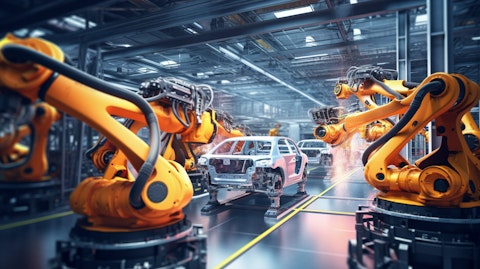In this article, we take a look at the 13 most advanced countries in robotics. You can skip our detailed analysis of the robotics industry and go directly to 5 Most Advanced Countries in Robotics.
According to Oxford Economics, the number of robots used globally has increased drastically over the past two decades, and the count now stands at a whopping 2.25 million. During this time, companies have increasingly realized the importance of automation to remain competitive in the industry, especially in the manufacturing industry. While the labor sector may feel threatened by these new developments in market trends, automation and the incorporation of robotics is the way forward to increase productivity and efficiency, and minimize the risk of accidents. For example, certain manufacturing jobs can be dangerous if not proceeded meticulously, such as assembling heavy parts and components or handling hazardous chemicals. However, robots can perform these jobs with more precision and efficiency while eliminating the risks of human injury.
Moreover, robotics and automation are saving a lot of money on wages for businesses. Yes, there is a substantial initial investment required to get the machine up and running, but the ROI is huge. Plus, the maintenance costs of a robot workforce are much lower than the monthly payrolls for a human workforce. Does this mean the human workforce is being pitted against the robotic workforce now? Fortunately, no. Despite jobs being lost in other sectors, more jobs will be created for humans in 60% of the IT services companies. In fact, the forecasts by the World Economic Forum suggest that automation will create 97 million new jobs for humans by 2025.
Automation and robotics will open different windows and unique opportunities for human workers. Moreover, robots can’t improvise; they do what they are programmed to do, which means they can not fully replace humans, as human minds will be needed to supervise them. So, robots may take over some jobs, but they will create plenty more, although these may require different specializations. As a matter of fact, the International Federation of Robotics (IFR) says that robots will work alongside humans rather than replace them in the future. governments and companies are also investing more in research and development (R&D) in the robotics industry and re-training employees to shape a better future.
Outlook of the Robotics Industry
According to the IFR, in 2022, there were 553,052 industrial robots installed in factories around the world. Compared to 517,385 industrial robots installed in 2021, there was a year-on-year growth rate of 5%. IFR has forecasted 600,000 units of industrial robots to be installed worldwide in 2024, with a growth rate of 7%.
By size, the global robotics technology market reached an estimated $72.17 billion in 2022 and is expected to reach around $283.19 billion by 2032. According to Precedence Research, during the forecast period of 2023 to 2032, the market is expected to grow with a registered CAGR of 14.7%. However, the growth of the robotics market is unequally shared between the regions.
Asia has the largest market for robotics, as 73% of all new industrial robots deployed in 2022 were installed in Asia alone. Meanwhile, Europe and the Americas had 15% and 10% of the total industrial robots installed in 2022. We will be discussing the largest markets and consumers within our list of most advanced countries in robotics below.
Some of the key players in the robotics and automation market are ABB Ltd (SWX: ABBN), Cognex Corporation (NASDAQ: CGNX), Toyota Motor Corporation (NYSE: TM), Nvidia Corporation (NASDAQ: NVDA), and Fanuc Corp (TYO: 6954).
ABB Ltd (SWX: ABBN) had a successful fiscal year in 2023 as it earned a total of $32.2 billion in revenue, an increase of 9.5% from the previous year. The year 2023 was also a positive year for Nvidia Corp (NASDAQ: NVDA), an American semiconductor and high-end GPU manufacturer company, as it raked $26.97 billion — a 0.22% increase from 2022.

13 Most Advanced Countries in Robotics
Our Methodology
For our list of the most advanced countries in robotics, we’ve ranked them based on the robot density in the respective countries’ workforce. We’ve used robot density data by country from the World Robotics Report 2023 published by the International Federation of Robotics.
By the way, Insider Monkey is an investing website that uses a consensus approach to identify the best stock picks of more than 900 hedge funds investing in US stocks. The website tracks the movement of corporate insiders and hedge funds. Our top 10 consensus stock picks of hedge funds outperformed the S&P 500 stock index by more than 140 percentage points over the last 10 years (see the details here). So, if you are looking for the best stock picks to buy, you can benefit from the wisdom of hedge funds and corporate insiders.
Here are the 13 most advanced nations in robotics.
13. The Netherlands
Robot Density in Workforce: 248 robot units per 10,000 employees
Located in Northwestern Europe, the Netherlands is known for its automation industry and the many robotics companies in the country. In 2021, the robot density in the manufacturing workforce was 224 robots for every 10,000 human workers, according to the International Federation of Robotics.
Naturally, this changed in 2022, and now the country has 248 robot units per 10,000 employees. The Netherlands is also home to the leading institutes in the field like Radboud University and Wageningen UR, which is the top institute working for innovation in robotics for agriculture.
12. Denmark
Robot Density in Workforce: 274 robot units per 10,000 employees
Denmark, a European country in the Scandinavian region, is one of the most developed countries in terms of science and technology today. In 2022, Denmark had 274 robots in its workforce for every 10,000 humans. Danish Technological Institute and Universal Robots are two of the key players in the Danish robotics industry. The former conducts research and development in a wide range of areas related to robotics and automation, including collaborative robots, service robots, and manufacturing automation. The institute also has several commercial projects in development.
On the other hand, Universal Robots is a leading manufacturer of collaborative robots (also known as cobots) based in Odense, Denmark. They’ve developed a range of cobots that are used in a variety of applications, including assembly, welding, packaging, and material handling.
11. Slovenia
Robot Density in Workforce: 284 robot units per 10,000 employees
Slovenia is a mountainous country in Central Europe. As of 2022, the robot density in Slovenia’s workforce was 284 robot units per 10,000 employees, according to the IFR. Apart from its own companies in the industry, the country also benefits from the activity of global key players like Fanuc Corp (TYO: 6954), Yaskawa, ABB, and Kuka in its robotics market.
10. United States
Robot Density in Workforce: 285 robot units per 10,000 employees
Number 10 on the list, the United States is one of the most advanced Western countries in robotics with a robots-to-human workers ratio of 285 robots per 10,000 humans. Some of the top tech corporations in the US like Nvidia Corporation (NASDAQ: NVDA), Rockwell Automation, Inc. (NYSE: ROK), and Cognex Corporation (NASDAQ: CGNX) are highly focused on robotics, which makes up for whatever little lacking the country has in the field.
9. Taiwan
Robot Density in Workforce: 292 robot units per 10,000 employees
Taiwan, formally known as the Chinese Tapei, is an island nation located in East Asia, and it’s one of the most advanced countries in the world today. It is also leading the way in the robotics sector, primarily due to its advanced chip-industry infrastructure, with companies like the Taiwan Semiconductor Manufacturing Company and ASE Technology operating within the country.
As of 2022, Taiwan has 292 robots per 10,000 employees in its workforce, per the World Robotics 2023 report by the International Federation of Robotics (IFR). Plus, Taiwan also has a number of startups in the robotics industry; the most notable of these include Techman Robot, iDrink, MIRLE, and HIWIN Corporation.
8. Switzerland
Robot Density in Workforce: 296 robot units per 10,000 employees
According to the IFR report, Switzerland is eighth on the list of most advanced countries in robotics. There are 296 robots for every 10,000 human workers in the country’s workforce as of 2022. It is also home to some of the most noteworthy robotics and automation companies in the world, like ANYbotics, ABB, and Swisslog. Moreover, there are many research institutions and universities in Switzerland like the Swiss Federal Institute of Technology (ETH) in Zurich that are actively involved in robotics research and development.
7. Hong Kong, SAR
Robot Density in Workforce: 333 robot units per 10,000 employees
Hong Kong, a country known for its advanced manufacturing and research infrastructure, has made significant strides in the robotics industry in recent times. As of 2022, there are 333 robots in Hong Kong for every 10,000 human workers, which translates to about 249,750 robots in total. Some of the top robotics companies in the country include Cornerstone Robotics, CRONUMAX, ABBYY, and Korah Limited.
6. Sweden
Robot Density in Workforce: 343 robot units per 10,000 employees
Sweden is another one of the most advanced countries in robotics. As of 2022, there are 343 robots per 10,000 workers in the country’s overall workforce. Sweden is also home to several research institutions and universities like the KTH Royal Institute of Technology in Stockholm and the Chalmers University of Technology in Gothenburg that are involved in the automation and robotics sector. In 2021, Sweden made headlines for Eve, a lab robot that helps automate research processes for scientists.
Click to continue reading and see 5 Most Advanced Countries in Robotics.
Suggested articles:
- 10 Best Robotics ETFs
- Top 20 AI and Robotics Companies Transforming the Agriculture Sector
- 20 Universities Providing Best Robotics Courses in 2023
Disclosure: None. 13 Most Advanced Countries in Robotics is originally published on Insider Monkey.





